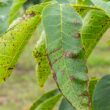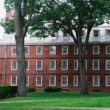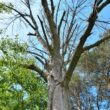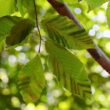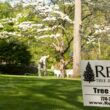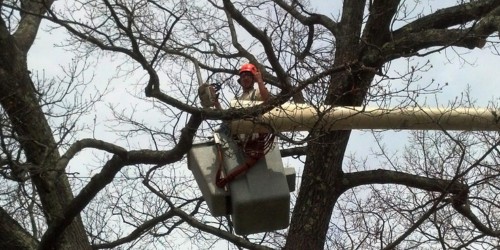When the July 2023 EF-1 tornado touched down along the Easton-Foxborough town line with 105 mph winds, it revealed something crucial about tree storm protection: not all PGR treatments are created equal. Red oaks that had received customized early-season applications showed significantly less damage than trees treated with generic timing protocols.
Unlike one-size-fits-all approaches, Certified Arborists customize plant growth regulator (PGR) treatments based on species biology, site conditions, and specific storm risks. This tailored approach creates stronger, more resilient trees that can withstand Bristol County’s diverse weather challenges—from hurricane-force winds to devastating ice storms.
Key Takeaways
- Species-specific timing maximizes protection by aligning treatments with each tree’s natural growth cycles and vulnerability windows.
- Site assessment determines optimal dosing and application methods based on soil conditions, exposure levels, and existing stress factors.
- Risk-based protocols prioritize high-value trees and those posing the greatest hazard if they fail during storms.
- Multi-factor evaluation considers tree health, age, location, and previous storm damage to create individualized treatment plans.
- Professional monitoring adjusts timing and concentration based on tree response and changing environmental conditions.

Mature trees like these in Bristol County residential settings represent significant property investments that require proactive storm protection.
How Do Arborists Assess Trees for Plant Growth Regulator Treatments?
Effective PGR customization begins with a comprehensive tree assessment that goes far beyond basic species identification. Certified Arborists evaluate multiple interconnected factors that influence both treatment effectiveness and storm protection outcomes.
Why Does Tree Species Matter for Plant Growth Regulator Timing?
Precise species identification forms the foundation of customized treatment. Many property owners are surprised to learn they have silver maple rather than red maple, or Norway maple instead of sugar maple. Each species has unique growth hormones, circulation patterns, and stress responses that determine optimal PGR timing and concentration.
For example, red oaks require 8-12 weeks for PGR circulation, making early June applications essential for hurricane season protection. Silver maples, however, continue active growth into fall, allowing later August treatments that provide dual protection against autumn storms and winter ice damage.
Understanding how to protect trees from nor’easter damage becomes increasingly important as these powerful winter storms intensify. While traditional methods like proper pruning to prevent storm damage remain essential, customized PGR treatments provide an additional layer of protection that strengthens trees from within.
What Site Factors Affect Plant Growth Regulator Treatment Success?
Environmental factors significantly influence plant growth regulator effectiveness and customize treatment protocols:
- Soil Conditions: Clay soils common in Attleboro residential areas slow PGR absorption, requiring adjusted application methods compared to well-drained sandy soils near Easton’s conservation areas.
- Sun Exposure: Full-sun trees experience different stress patterns than those in partial shade, affecting both PGR uptake and storm vulnerability.
- Wind Exposure: Trees in open landscapes face greater wind loads, warranting higher concentration treatments than protected specimens.
- Proximity Risks: Trees near homes, power lines, or high-traffic areas receive priority treatment with enhanced protection protocols.
The August 2019 microburst in Attleboro demonstrated how quickly severe weather can cause extensive tree and power line damage, affecting thousands of residents. These events highlight why customized assessment considers each tree’s specific risk factors.
How Does Tree Health Impact Plant Growth Regulator Effectiveness?
Existing stress factors dramatically affect PGR absorption and effectiveness. Arborists assess:
- Drought damage that compromises vascular function
- Previous storm injury affecting structural integrity
- Pest or disease issues impacting overall tree health
- Root damage from construction or soil compaction
- Age-related decline affecting treatment response
“Generic plant growth regulator applications ignore the individual factors that determine treatment success. A drought-stressed red oak in compacted soil needs a completely different protocol than a healthy specimen in ideal conditions. That’s why our assessment process examines every factor before developing a customized treatment plan.” – Adam Winsor, Regal Tree Plant Health Care Manager

Storm damage like this demonstrates why Bristol County property owners need proactive tree protection measures, including properly timed PGR treatments.
What Trees Need Different Plant Growth Regulator Timing for Storm Protection?
Understanding how different species respond to PGR treatments allows arborists to customize timing, concentration, and application methods for optimal storm resistance.
When Should Red Oaks Get Plant Growth Regulator Treatments for Storm Protection?
Red oaks receive customized early June applications designed to build hurricane season protection. The timing aligns with the species’ peak growth hormone production, ensuring maximum PGR circulation before stress hormones increase during summer heat.
Some aspects that set red oaks apart from other local trees include:
- Soil drainage determines application concentration (higher doses for clay soils)
- Tree size affects dosage calculations and injection point spacing
- Wind exposure level influences follow-up treatment timing
- Previous storm damage may require modified application methods
This species-specific approach produces measurably stronger wind resistance compared to generic fall applications that miss the optimal hormone window.
What’s the Best Plant Growth Regulator Timing for Silver Maples?
Silver maples benefit from late August treatments customized to address the species’ notorious brittleness during both fall hurricanes and winter ice storms. The timing takes advantage of continued late-season growth while building structural improvements for challenging winter conditions.
Some of the factors we consider when customizing a PGR program for silver maples include:
- Branch structure assessment determines concentration levels
- Ice storm history influences treatment frequency
- Proximity to power lines may require enhanced protection protocols
- Soil pH affects absorption rates and application methods
When Do Pine Trees Need Plant Growth Regulator Applications?
Eastern white pines can receive treatments from November through February, allowing maximum scheduling flexibility. Arborists customize timing based on individual tree needs and upcoming weather forecasts.
Some of the unique problems facing pines that we consider when applying a PGR treatment include:
- Snow load exposure determines treatment intensity
- Needle retention issues may require modified application timing
- Soil moisture levels affect winter application success
- Previous ice damage influences dosage calculations
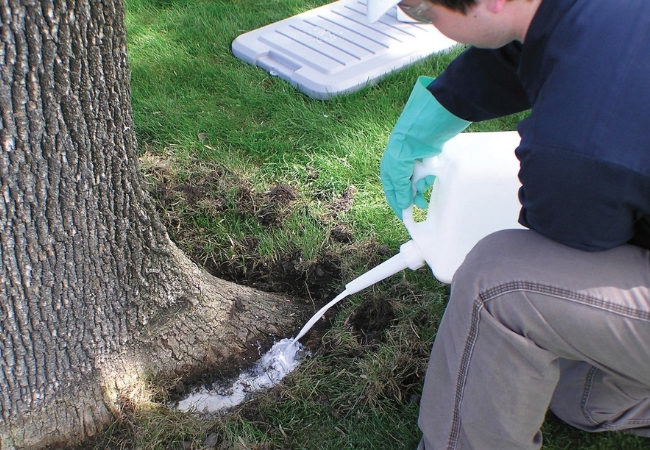
Professional PGR application requires specialized equipment and proper safety protocols to ensure effective treatment and environmental protection.
Why Professional Plant Growth Regulator Application Works Better Than DIY Treatments
The difference between customized and generic PGR treatments becomes clear when examining treatment outcomes and long-term tree health.
What Problems Do One-Size-Fits-All Plant Growth Regulator Treatments Have?
Standard PGR applications typically use:
- One-size-fits-all timing regardless of species
- Standard concentrations ignoring site conditions
- Limited follow-up assessment or adjustment
- No consideration of individual tree stress factors
What Are the Benefits of Customized Plant Growth Regulator Applications?
Professional customization provides:
- Optimized timing based on species biology and local climate patterns
- Adjusted concentrations reflecting soil conditions and tree health status
- Modified application methods accounting for site constraints and safety requirements
- Ongoing monitoring with treatment adjustments based on tree response
This tailored approach produces consistently better results, with treated trees showing improved storm resistance, faster recovery from stress events, and enhanced long-term health.
According to the EPA, climate change is increasing storm frequency and intensity across our region. Property owners in Taunton, Norton, and surrounding communities can no longer rely on reactive tree care after storm damage occurs.
How Do Plant Growth Regulators Make Trees Storm Resistant?
Customized PGR treatments enhance storm resistance through targeted physiological changes that strengthen trees from the cellular level up. Understanding these mechanisms explains why species-specific timing and dosing produce superior results.
PGRs work by temporarily reducing growth hormone production, redirecting tree energy toward:
- Enhanced root development for better storm anchorage
- Increased wood density for stronger branch attachments
- Improved bark thickness providing ice storm protection
- Reduced height extension minimizing wind sail effects
The key to customization lies in timing these changes to align with each species’ natural growth cycles and vulnerability windows. Professional assessment ensures treatments maximize protective benefits while maintaining tree health and vitality.
The nutritional support provided through professional fertilization and plant health care programs works synergistically with PGR treatments to maximize storm protection benefits. Proper nutrition ensures trees can effectively use the growth-regulating effects while maintaining overall health and vitality.
PRO TIP: Plant growth regulators are specialized treatments that require precise dosing, proper timing, and professional equipment for safe and effective application. Attempting DIY PGR treatments can harm your trees, contaminate groundwater, and void product warranties. Always hire a Certified Arborist for PGR applications to ensure optimal results and environmental protection.
Frequently Asked Questions
How do arborists determine the right timing for my specific trees?
Certified Arborists evaluate species biology, current tree health, soil conditions, and local climate patterns to determine optimal application timing. Each tree receives an individual assessment rather than generic scheduling.
What factors influence PGR concentration levels?
Soil type, tree size, health status, wind exposure, and species-specific absorption rates all influence dosage calculations. Professional assessment ensures safe, effective concentration levels for each situation.
Can treatments be adjusted if trees don’t respond as expected?
Yes, professional monitoring allows for treatment adjustments based on tree response. Arborists can modify timing, concentration, or application methods to optimize protection for individual trees.
How long do customized PGR treatments provide storm protection?
Properly customized treatments typically provide 2-3 years of enhanced storm resistance. The exact duration depends on species, site conditions, and treatment precision. Professional monitoring determines optimal reapplication timing.
What’s the difference between customized and standard PGR applications?
Customized treatments consider species biology, site conditions, tree health, and specific protection goals. Standard applications use generic timing and dosing that often miss optimal effectiveness windows for individual trees.
Which Bristol County trees benefit most from customized PGR storm protection?
High-value trees, those near structures or power lines, and species particularly vulnerable to local storm conditions (like silver maples and eastern white pines) show the most dramatic improvement from properly customized treatments.
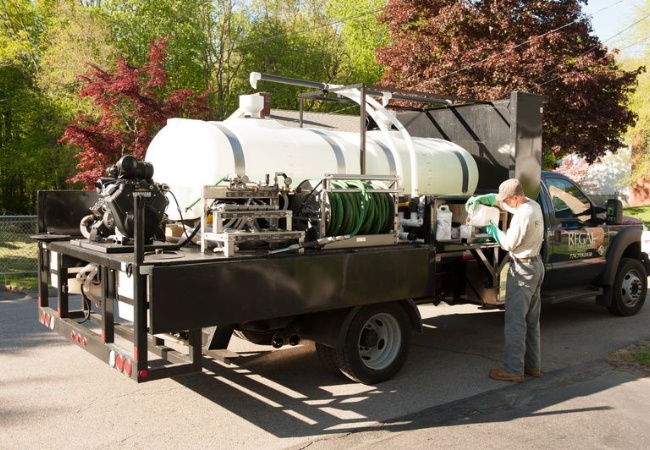
Regal Tree’s Certified Arborists bring professional expertise and proper equipment to every PGR storm protection project.
Protect Your Trees with Professional PGR Customization
Don’t settle for generic storm protection when your valuable trees deserve customized care. Regal Tree and Shrub Experts’ Certified Arborists provide comprehensive assessments and species-specific PGR treatments designed for Bristol County’s unique storm challenges.
Our professional team evaluates each tree individually, developing customized treatment protocols that maximize storm protection while maintaining long-term tree health and beauty. Call 774-719-2450 today or request a quote online for a professional PGR assessment and customized storm protection plan.

